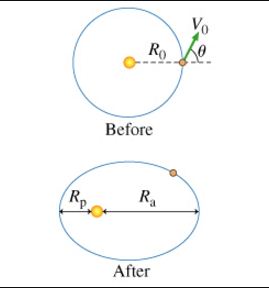Assignment:
Total energy and momentum of the asteroid after a collision
Q: A small asteroid is moving in a circular orbit of radius R_0 about the sun. This asteroid is suddenly struck by another asteroid. (We won't worry about what happens to the second asteroid, and we'll assume that the first asteroid does not acquire a high enough velocity to escape from the sun's gravity). Immediately after the collision, the speed of the original asteroid is V_0, and it is moving at an angle (theta) relative to the radial direction, as shown in the figure. Assume that the mass of the asteroid is (m) and that the mass of the sun is(M) , and use (G) for the universal gravitation constant.
Since the asteroid does not reach escape velocity, it must remain in a bound orbit around the sun, which will be an ellipse. Take the following steps to find R_a and R_p, the aphelion and perihelion distance of the asteroid after the collision. (The aphelion is the point in the orbit farthest from the sun, and the perihelion is the point in the orbit closest to the sun.)
As in most orbit problems, the most fundamental principles involved are energy and angular momentum conservation.
A) What is the total energy of the asteroid immediately after the collision? Express the total energy in terms of some or all of the variables R_0,V_0 ,theta , and some or all of the fixed constants m, M, and G.
B) What is L, the magnitude of the angular momentum of the asteroid immediately after the collision, as measured about the center of the sun? -Express the total energy in terms of some or all of the variables R_0,V_0 ,theta , and some or all of the fixed constants m, M, and G.
C) Write an expression for the total energy at aphelion in terms of the variables characterizing the motion there (i.e., V_a and R_a).
-Express in variables
D) What is the magnitude of the angular momentum of the asteroid at aphelion? Express in variables V_a and R_a and some or all of the fixed constants
E)Write an expression for V_e.
Express in variables R_e and the known quantity L, as well as some or all of the fixed constants.
